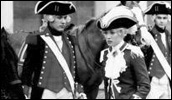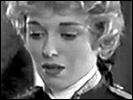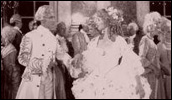Lady Oscar
- Year
- 1979
- Original title
- Berusaiyu no Bara
- Japanese title
- ベルサイユのばら
- Director
- Cast
- Running time
- 124 minutes
- Published
- 21 October 2007



by Jasper Sharp
With its pan-European cast and Umbrellas of Cherbourg-director Jacques Demy behind the camera, Lady Oscar is hardly recognisable as a Japanese movie. However this lavish Toho production is in fact based on one of the most phenomenally popular shojo mangas (girls' comics) ever released.
Set in the palace of Louis XVI, Riyoko Ikeda's 1700-page Rose of Versailles (serialised in 1972-73) is a wistful account of the years leading up to the French Revolution, ending with the storming of the Bastille in 1789, and with the historical facts tempered with lashings of doe-eyed romanticism doled up for its female readers. The story was further popularised with its first performance by the all-female Takarazuka theatrical troupe in 1974 (the play is revived regularly), and a 41-episode animated TV series produced by Tokyo Movie Shinsha, first broadcast on Nihon Television in the fall of 1979.
In the opening scenes, Oscar's mother dies in childbirth as she delivers a single daughter, Françoise, leaving her father Général de Jarjayes (Kingston) gasping for a male son and heir. In desperation, he renames his new offspring Oscar and raises her as a boy, initially played by a young Patsy Kensit (in the days when she was better known for her Bird's Eye pea adverts rather than her later guises of rock wife and slumming soap star). Fully grown, Oscar is delivered into the court at Versailles, still in male attire, to work as a palace guard, finding herself as a close aide and confidente to the Austrian-born princess Marie Antoinette (Böhm), newly ensconced on the French throne besides her king (Budd). But Oscar's ingrown sense of duty doesn't permit her to succumb to the possible romantic yearnings of Andre (Stokes), the childhood friend with whom she grew up.
Meanwhile, as the nobility crawl around the cobbled streets in their horse-drawn carriages, haranguing pretty young peasant girls and tempting them into their rococo boudoirs with offers of bread and cake, the winds of change can be felt in the air, and swept along by the tide, Andre finds himself siding with the revolting peasants. With Oscar still firmly allied with her more privileged associates at the palace after allowing herself to be swept off her feet by roguish libertine Hans Axel von Fersen of Sweden (Bergström), Andre finds his loyalties severely divided.
Crucial to the manga's appeal was the sexual ambivalence of the title character, which here provides an early role for British actress Catriona MacColl, better known for her appearances in the gruesome zombie flicks of Italian director Lucio Fulci during the 1980s. Bosom heaving beneath her blouson, the swashbuckling young beauty in jodhpurs is a suitably androgynous figure to act as a safety valve for any latent same-sex fantasies in its target audience. A soft-focus scene of Oscar airing her womanly torso as Andre peeps into her boudoir may seem gratuitous given the almost childlike naïveté of the film's historical interpretation, but fully justified by the story's own internal logic.
It can't be denied that Lady Oscar is an inexorably bad film, a Japan-funded addition to the genre of international co-productions rife in the 80s known as the "Euro-pudding", typified by leading turns from long-forgotten British actors camping it up with a pantomime sense of conviction against an extensive French supporting cast, flamboyant costumes, and historical backdrops (much of it shot on location at Versailles), and a strange absence of any sort of national identity. But whilst the film may represent a particular black spot in the late career of its director, it is one of those works that is so compellingly awful that entire dissertations could be written about what exactly went wrong.
For that reason alone is it worth drawing more attention to, and for Patsy Kensit fans. Those that are still interested, the version released in Japan is in English with Japanese subtitles.